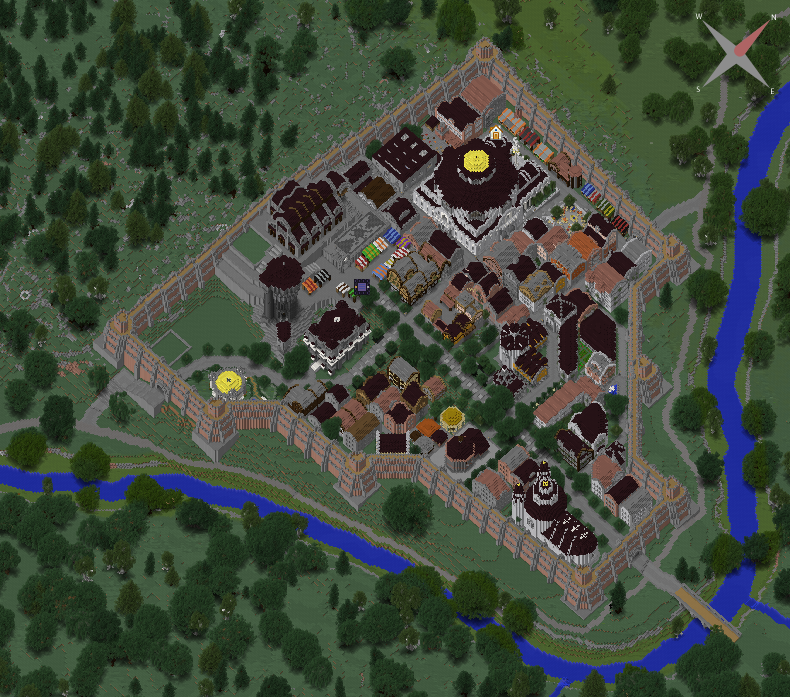Kosel

Kosel is the largest city of Silvetia and the seat of its government. It is situated on the Western (left) bank of the river Schwarzwasser in forested, hilly terrain.
Overview
Kosel is defined by two main features: Its thick red city walls and the elevation rise towards the center, with the highest point of the city being the Duke's Hall plateau in the Western city center. The city of Kosel can be entered via three main gates:
- The Northern Gate, called Merchant Gate
- The Eastern Gate, called Bridge Gate
- The Southern Gate, called Steep Gate
The Duke's Ave connects the Eastern Gate with the Duke's Hall plateau, dividing Kosel into a southern part largely dominated by religious buildings and low status housing, and a northern part largely dominated by public services and high status housing.
Sights
- City Walls
- With a height of up to 20 Meters and an average thickness at the base of more than eight Meters, the Kosel city walls are an imposing sight. To reinforce its effect on the enemy's morale, the walls are built of red granite. This earned them the nickname "Rosenhecke" (rose hedge). In its entire history, the city of Kosel has never been taken by force, so the walls stand undefeated.
- Kosel Parliament
- Duke's Hall
- In the days of the Duchy of Silvetia, the Duke's Hall on top of the city's highest plateau was Kosel's dominating feature. It was the seat of the Duke for purposes of representation and courting, housing hundreds of noblemen and their entourages for days at a time.
- Long Fred
- The old tower just south of the Duke's Hall is the tallest building of Kosel. It was the residence of the Duke's family and now serves as a meeting place for the Republic's elite. Once a year it is being opened to the public to celebrate the beginning of Spring by hanging long and richly decorated paper strips out of the top floor's windows. During the Reign of Duke Micha I (The Mad) it was considered a capital offense to call this tower "Long Fred", instead enforcing the use of the offical name "Ducal Tower". With the end of the Duchy the official name is shunned by the natives and using it is an easy way to start a bar brawl.
- Eagle Plaza
- Situated rigth below the Duke's Hall, the Eagle Plaza is the largest open space in all of Kosel without any permanent buildings. It is frequently used for speeches, festivities and other events. It features a giant stone-and-black-marble mosaic depicting the Silvetian Eagle flag, hence its name.
- High Market
- Right below the Eagle Plaza, the High Market is the largest of the three markets of Kosel. It is well known for its exotic goods, which are generally of better quality and much higher price than the ones offered in the Long Market.
- Long Market
- Occult Market
- Situated in the southern city quarter in between the religious centers of worship, the Occult Market sells a vast variety of goods related to worship, healing, magic, knowledge and general exotic randomness. It is the smallest of the three Kosel markets but by far the most famous one, attracting sightseers, worshippers and eccentrics from all over Hasperia.
- Temple of Pengu
- Although their temple is one of the largest religious buildings in Kosel, the Pengu community is by far the smallest of them all. According to the Pengu priests, the Kosel temple is among the smallest of their houses of worship. A monument not only to the greatness of Lord Pengu, but more so the the megalomania of its clergy.
- St. Anna Minster
- Mikkelskirche
- The Balthasarian church was the first religious building in Kosel, erected during the reign of Bishop Balthazar IIIIII. of Greifenhausen. There is a strong Balthazarian community in Kosel, constituting the second largest religious group in the city after the Sotiran church.
- Temple to Azura
- City Hall
- Civil War Monument
- Public Baths
- Sign Tower
- Botanist's Alley
- Count Hohenstein Plaza
- Koseler Freiheit